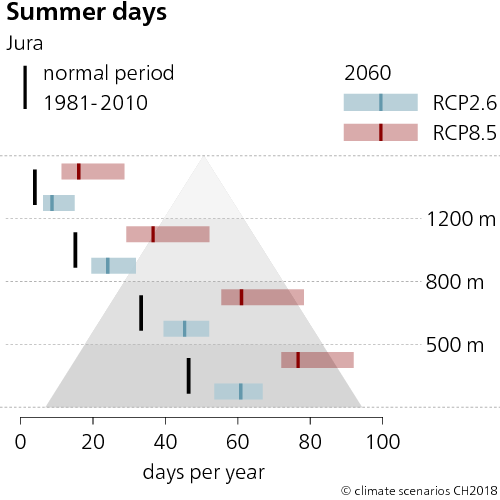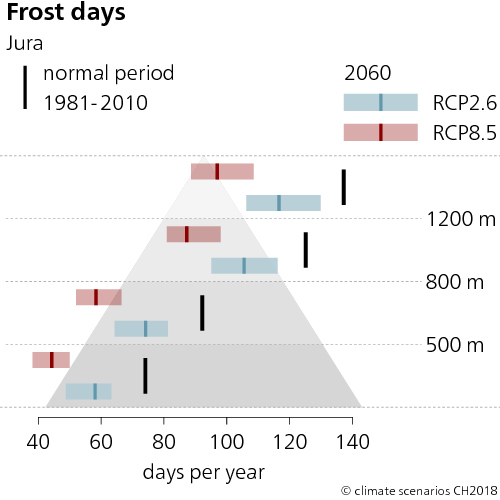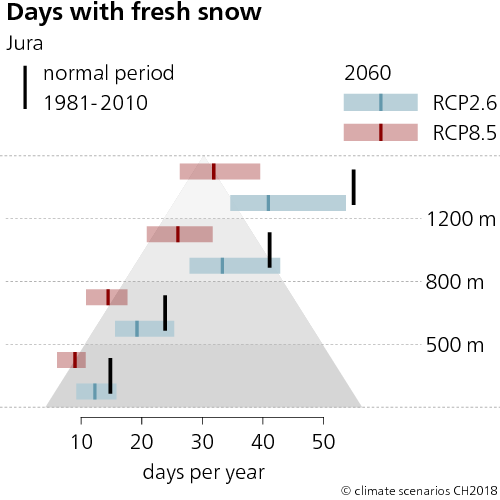The highest peaks in the Jura are located at more than 1,200 metres above sea level (m a.s.l.). At the same time, the region is home to some very low-lying areas around Basel and Schaffhausen. These two cities in particular, along with their surrounding areas, will have to expect an increase in the number of summer days and tropical nights. Without climate change mitigation, the higher areas of the Jura region will face significantly fewer days with frost or fresh snowfalls.
The figures below illustrate the changes of four climate parameters at four elevations in the Jura region. The elevations are shown in the right-hand half of the charts. The vertical line shows the observed average of today (normal period of 1981 to 2010). The coloured bars show the possible range for the two emission scenarios RCP2.6 and RCP8.5 of the respective climate parameter during the period around 2060. The vertical coloured lines show the median values across simulations with different climate models, which represent the expected values.
What do RCP2.6 and RCP8.5 mean? You can find an explanation of the emission scenarios here.
Summer days now
In the lower-lying regions below 500 m a.s.l. there are 46 summer days per year, and at higher elevations in the Jura, 4 days.
Summer days around 2060
In the scenario without climate change mitigation (RCP8.5), the low-lying areas can be expected to experience an average of around 80 summer days per year by the middle of the century, whilst areas above 1,200 m a.s.l. can expect around 15 summer days. With mitigation (RCP2.6), the number of summer days below 500 m a.s.l. can be kept to around 60. At higher elevations, around 10 summer days can be expected by the middle of the century.
Tropical nights now
In the Jura region, years without any tropical nights occur regularly. The long-term average number is close to zero for this Region.
Tropical nights around 2060
Without climate change mitigation (RCP8.5), by the middle of this century, tropical nights could occur at all elevations in the Jura; below 500 m a.s.l., between 4 and 13 tropical nights per year can be expected. With climate change mitigation (RCP2.6), the number of tropical nights is expected to remain very small, even in the lower-lying areas.
Frost day now
In today’s climate, more than one third of all the days in the year are frost days at high elevations in the Jura. The lowest-lying areas have around 75 frost days.
Frost days around 2060
Without climate change mitigation (RCP8.5), by the middle of the century, an average of 45 frost days can be expected at elevations below 500 m a.s.l., and at altitudes above 1,200 m a.s.l, less than 100 frost days can be expected. With mitigation (RCP2.6), there would still be around 60 frost days at lower elevations, and 115 at higher elevations.
Days with fresh snow now
On the highest peaks in the Jura there are currently 55 days of fresh snowfall per year on average. In areas at elevations between 800 and 1,200 m a.s.l. there are 41 days of fresh snowfall per year.
Days with fresh snow around 2060
Without climate change mitigation (RCP8.5) the areas at higher elevation can expect around 30 days of fresh snowfall a year, and at elevations between 800 and 1,200 m a.s.l. around 25 days. The frequency of snowfall would almost halve. With climate change mitigation (RCP2.6) however, there would still be 40 days of fresh snow per year in the Jura mountains.
Last modification 07.08.2020









